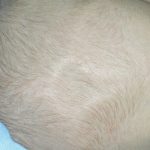 Soft spot on an infant’s skull.
Soft spot on an infant’s skull.
The soft cartilage between the bony sections of a baby’s skull.
Incompletely ossified spaces or soft spots between the cranial bones of the skull of a fetus or infant.
A space between bones of the fetal or young skull covered with a membrane. The shows a rhythmic pulsation produced by the flow of blood in the vessels of the brain.
Two soft spots in a baby’s skull, covered only by membranes at birth, where the bones of the skull fuse and harden later; the rear one fuses in about two months and the top front one in about 18 months. It is the softness of a baby’s skull that allows the head to pass through the birth canal during childbirth. Some babies, especially those with Down’s syndrome, have more than two fontanelles. Abnormalities of the fontanelles are associated with some brain disorders. They may temporarily bulge when a baby cries, but persistent tension in the membrane can indicate physical problems, such as hydrocephalus.
One of two soft areas on an infant’s head where the skull bones have not yet joined. The fontanelle that is located at the top of an infant’s head usually closes by 14 months. In most children, the fontanelle at the back of the head is closed at birth. In others, it closes by 3 or 4 months of age. Normal handling and washing of an infant does not harm the fontanelles. A baby’s soft spot normally bulges when he or she is crying. However, a fontanelle that is firm and bulging when a baby is not crying can indicate that the brain is under pressure from hydrocephalus, an accumulation of fluid; an infection; or a tumor. A sunken fontanelle may indicate dehydration. It is important to consult a pediatrician in these cases.
An opening in the skull of a fetus or young infant due to incomplete ossification of the cranial bones and the resulting incomplete closure of the sutures. The anterior fontanelle occurs where the coronal, frontal, and sagittal sutures meet; the posterior fontanelle occurs where the sagittal and lambdoidal sutures meet.
Areas on the head on which bone has not yet formed. The chief of these is the anterior fontanelle, situated on the top of the head between the frontal and two parietal bones. In shape it is four-sided, about 25 mm (1 inch) square at the time of birth, gradually diminishing until it is completely covered by bone, which should happen by the age of 18 months. The pulsations of the brain can be readily felt through it. Delay in its closure is particularly found in cases of rickets, as well as in other states of defective development. The fontanelle bulges with raised intracranial pressure from hydrocephalus and meningitis, and is depressed by dehydration.
In a baby’s skull, there are two membrane-covered spaces between the bones. At birth, the skull bones are not completely fused, and these soft areas can be felt on the scalp. The first one is the anterior fontanelle, which has a diamond shape and typically closes by around 18 months of age. The second one is the posterior fontanelle, which is triangular and typically closes within the first two months after birth.
When a baby cries, it is normal for the fontanelles to become tense and bulge out. However, persistent tension at other times may indicate an abnormality, particularly hydrocephalus, which is the accumulation of fluid in the skull. On the other hand, a sunken fontanelle could be a sign of dehydration. If a fontanelle is unusually large or takes a long time to close, it might be due to a brain abnormality or a disorder affecting the skull bones, such as rickets. In some cases, early closure of the fontanelles can lead to a deformity known as craniosynostosis.
In some cases, a third fontanelle may be observed between the other two, and this is a characteristic feature of Down’s syndrome. Additionally, occasionally, a baby may have extra bones in the anterior fontanelle, but this is considered a normal variation. Over time, these extra bones fuse into the skull as the gap between them closes.
The fontanelle is the soft area on a baby’s skull where the skull bones have not yet fused together. In this region, the brain is covered only by its membranes and the scalp. This area can bulge when there’s increased pressure within the baby’s skull and become depressed when the baby is dehydrated. Typically, the fontanelle naturally closes between 18 to 22 months of age. There are a total of six potential fontanelles on a baby’s skull.
